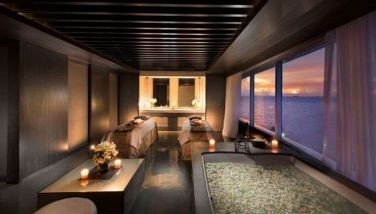Journey to a Muslim past
December 23, 2001 | 12:00am
 Two dailies of Dec. 17 carried the picture of the Taluksangay Mosque on the outskirts of Zamboanga City. I was so thrilled to see that picture. Taluksangay is the home of the Sama Banguinguis, the subject of my masteral thesis in Philippine history. Taluksangay was also home to me where I spent years doing my research. Nur Misuari found protection in Taluksangay also. Taluksangay is a small islet of 8.3668 hectares surrounded by mangroves 20 kilometers from Zamboanga City.
Two dailies of Dec. 17 carried the picture of the Taluksangay Mosque on the outskirts of Zamboanga City. I was so thrilled to see that picture. Taluksangay is the home of the Sama Banguinguis, the subject of my masteral thesis in Philippine history. Taluksangay was also home to me where I spent years doing my research. Nur Misuari found protection in Taluksangay also. Taluksangay is a small islet of 8.3668 hectares surrounded by mangroves 20 kilometers from Zamboanga City.
It is in this islet where the Sama Banguinguis led by the Nuño family were resettled after their exile by the Spaniards in 1858 to Isabela Province, from their island, Balanguingui, located just below Basilan in the island municipality of Tongkil, Sulu.
Nuño in 1880 selected Taluksangay for its location, being adjacent to smaller islands thereby protected from storms and gigantic waves. Its name is derived from the words "Taluk" and "Sangay." Taluk means violet and sangay means a peaceful docking place. Violet is the color of the Banguingui tribe.
Let me tell you the story of the Sama Banguinguis of Balanguingui Island, now settlers of the progressive Taluksangay islet. But first the irony of life! The child of a captive grandmother who was the wife of the fiercest "pirate" of the south, baptized and educated by a Catholic priest, founded the greatest Islamic Center of Taluksangay.
Panglima Taupan with his bravest warriors were away trading in Borneo. Climbing over coal and stone walls, Claveria’s men attacked and captured the Samas in their four forts. All the women and children, who were left behind and who had not killed themselves like the others, were brought to Zamboanga City.
When Panglima Taupan returned, he found his settlement deserted and burned to the ground. Worst of all, his wives were missing. Years later the Sama prisoners from Zamboanga were transferred to Tondo and Cavite and much later to Fort Santiago and finally in 1866 exiled to the Cagayan Valley. Thus marked the greatest punishment, the diaspora of these Muslim captives, seafarers of the south, forced to till the soil as ignorant farmers in Isabela up north. The brave Panglima in the meantime did not despair and continued his raids.
On his seventh trip, Taupan headed directly for the Ilocos provinces landing in Vigan where the natives helped him locate the Sama Banguingui captives. Taupan’s emissary, going via Aparri, found the young Dela Cruz by then Christianized, a 10-year-old boy, orphaned and residing in Isabela. Taupan and his son, according to this legend, finally met in Vigan.
Family oral history says Taupan made his son promise that should he (Taupan) fail to free the Banguinguis in Isabela his son should bring them to Mindanao where they could live together as one people, as Muslims.
Taupan eventually fell ill, a victim of a smallpox epidemic, and died in Vigan. Family memories wane at this point.
Actually my archival hunt left me with an allergy and blackened hands from the dust, but never mind. It brought me to Taupan’s son, Antonio dela Cruz, in Cavite where he served as a sacristan to a friar who educated him in the Spanish ways before he was transported to Isabela with the group of Samas.
Meanwhile Governor Severo Ventura y Nuño used him as an escrebiente or secretary because Antonio was a Moro-Muslim who could speak and write Spanish. In gratitude for the Governor’s trust, Dela Cruz adopted the name of his patron, Nuño.
Hadji Jainudin Nuno, my bapa, further renovated the mosque giving it its permanent site, so large, so elegant and imposing. The mosque is across the road from Bapa’s house which was by the sea. At 4 a.m. the call to prayer sounded so very loud I would cover my ears as I hid under the blanket for it was so cold too. Hadji Jainudin has since opened four madrasahs or Islamic schools in Taluksangay.
To see it is to realize what respect for history, love of ancestors and determination can achieve. The Samas have a home in a well-planned village that looks different every year, with so much improvements. More homes, more children, running water, hanging bridges, fish, bakawan and agar-agar cultivation have given good economic returns through the Nuños, patriarchs of the Samas.
At that time the Spanish forces undertook a surprise attack on the private stronghold of the Hadji Abdulla Nuño’s father on the island of Balanguingui. The chief himself happened to be absent at the time but his entire family including Hadji Abdulla Nuño, then but a half-grown boy, and large number of retainers were taken captives by the Spanish and were shipped to Cavite where they were held prisoners for sometime. During this period Hadji Abdulla Nuño was used by the Commandant of the Cavite Naval Station as a houseboy and compelled to submit to Christian baptism.
Later the entire lot of Moro captives were turned by the Spanish government to the Compania Tabacalera and shipped to the latter’s hacienda in Cagayan Valley near the town called Tumauini. After 18 years of captivity there Hadji Abdulla Nuño secured permission from the Spanish Governor General to return with some of his people to Zamboanga. Shortly afterwards he and the others made a pilgrimage to Mecca which conferred on them the titles of Hadji. Returning to the Philippines they established under Hadji Abdulla Nuño’s leadership at Taluksangay – where there gradually collected a group of Arab, Malay and Moro Sheiks and Hadjis – by far the most important and assertive center of Mohammedan propaganda and determined opposition to the development of the policies of the government since the beginning of the American occupation.
Hadji Jainudin Nuño, the father of Sama Banguinguis of the 20th century, was the happiest man at the recognition of his ancestors’ religious propagation by the national government. I was very blessed to have embarked on this eight-year search through Fr. Hilario Lim’s insistence. It was as though Panglima Taupan wanted me to ply the seas with him, which I did, and write about his descendants, his people in Sulu, Tawi-Tawi, Taluksangay and Isabela.
BrandSpace Articles
<
>















